
The first detailed global assessment of the electricity generation potential of rooftop solar photovoltaics (PV) technology was carried out by researchers at MaREI, the SFI Research Centre for Energy, Climate and Marine at the University College Cork (UCC), in collaboration with research partners. The findings have been published in Nature Communications.
Rooftop solar photovoltaics (PV) technology, including roof mounted solar panels used in home, commercial and industrial buildings, is currently the fastest deployable electricity generation technology and is forecast to supply 25-49 per cent of global electricity needs by 2050. Despite these predictions, a global assessment of the technology's electricity generation potential and the associated costs remains a challenge, the team said.
MORE FROM ENERGY & ENVIRONMENT
The research team, including lead author Siddharth Joshi, together with UCC colleagues Professor Brian Ó Gallachóir, Dr Paul Holloway and colleagues at Imperial College London, Columbia University, and Ahmedabad University, assessed the electricity generation potential of rooftop solar PV globally and the associated costs. The authors mapped 130 million km2 of global land surface area to identify 0.2 million km2 of rooftop area using a novel Machine Learning algorithm. This rooftop area was then analysed to quantify the global electricity generation potential of rooftop solar PV.
"For the first time, we can analyse the spatial and temporal characteristics of global rooftop photovoltaics with improved accuracy using a combination of big data, machine learning and GIS. This study can aid in improved representation of rooftop solar photovoltaics in global energy systems" said UCC researcher Siddharth Joshi.
According to the team, a global potential of 27 petawatt-hour per year can be attained at a cost of between US$ 40–280 per megawatt-hour with the greatest electricity generation potential in Asia, North America and Europe. The lowest cost for attaining the potential energy is in India (US$66 per megawatt-hour) and China (US$68 per megawatt-hour), while the UK and USA are among the costliest countries. The authors suggest that the electricity generation potential of rooftop solar panels exceeded the global yearly aggregated energy consumption in 2018, but its future potential depends on the development and cost of storage solutions.
“The open data generated in this research helps to quantify, locate and prioritise investment in zero-carbon electricity systems,” said MaREI’s Dr James Glynn. “By mapping the solar PV rooftop potential in high resolution globally, development banks and energy agencies in developing countries are better informed as to the technology's role in enabling sustainable development towards climate action and affordable and clean energy."




Nanogenerator consumes CO2 to generate electricity
Whoopee, they've solved how to keep a light on but not a lot else.